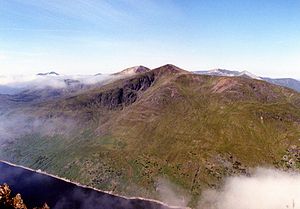Stob a' Choire Mheadhoin: Difference between revisions
Created page with '{{Infobox hill |name=Stob a' Choire Mheadhoin |county=Inverness-shire |range= |SMC=4 |picture=Stob_a'_Choire_Mheadhoin_from_Stob_Coire_Sgriodain.jpg |picture caption=Stob a' Choi…' |
No edit summary |
||
| Line 34: | Line 34: | ||
{{reflist}} | {{reflist}} | ||
{{DEFAULTSORT:Stob A Choire Mheadhoin}} | |||
{{Munro}} | {{Munro}} | ||
Revision as of 13:40, 20 November 2013
| Stob a' Choire Mheadhoin | |
| Inverness-shire | |
|---|---|
 Stob a' Choire Mheadhoin across Loch Treig | |
| Summit: | 3,625 feet NN316736 |
Stob a' Choire Mheadhoin is a mountain in Inverness-shire, just east of the Grey Corries range and 12 miles east of Fort William. It reaches a height of 3,625 feet at its summit, and so it qualifies as a Munro.
Overview
Stob a' Choire Mheadhoin, with a height 3,625 feet, is one of the higher Munros. It is closely associated with the adjoining peak of Stob Coire Easain which is just 30 feet higher and stands less than a mile to the southwest across a high col with a height of approximately 3,166 feet. The two are usually climbed together and have the informal nicknames of “The Easains” or “The Stob Coires”.

Stob a' Choire Mheadhoin is fortunate to be regarded as a separate mountain rather than a subsidiary “top” of Stob Coire Easain, the two being so closely joined. The hill was not named on older maps, and appeared as unnamed summit. However its dominating presence above Glen Spean is unignorable, and it has been listed as a Munro in its own right ever since the first publication of Munro's Tables in 1891.[1]
The best views of Stob a' Choire Mheadhoin are from the northeast, from where it is seen as a separate mountain. From the Laggan Dam it appears as a conical peak, while from Stob Coire Sgriodain on the opposite side of Loch Treig, the mountain shows the steep slopes which fall into the loch and its impressive craggy Coire Meadhon which gives the mountain its name, which translates as “Peak of the Middle Corrie“.[2]
Geography
The mountain has a long northeast ridge which descends for over 3 miles to the hamlet of Fersit at the head of Loch Treig. This ridge is the most common route of ascent and though mostly a moderate gradient it does have several steep sections, most notably the rocky climb up to Meall Cian Dearg which requires some mild scrambling. The mountains eastern flank falls steeply to Loch Treig with the slope rising from loch side to summit for 850 feet and an average gradient of over 30 degrees. These slopes are well seen when travelling on the West Highland Railway on the east side of the loch.
A ridge goes southwest from the summit to connect to the mountains twin Munro of Stob Coire Easain; this ridge hugs the lip of the impressive Coire Easain Beag which stands between the two mountains. This corrie has patches of red rock on its upper slopes especially on its Stob a' Choire Mheadhoin side, a point on the ridge at the head of the corrie is actually named Càrn Dearg ("Red Cairn") on the OS map.
There are several corries on the eastern side of the mountain, the most impressive of these by far is Coire Meadhon ("Middle Corrie") which falls directly from the summit with steep crags on its southern side. The northern slopes of the mountain descend into Coire Laire which is drained by the Allt Laire which goes north to join the River Spean as does all rainfall from the mountain.
Ascents
The most popular starting point for the ascent of Stob a' Choire Mheadhoin is the small hamlet of Fersit at grid reference NN350784, from there the long NE ridge can be accessed and followed to the summit. An alternative ascent can be made from Corrour railway station utilising the West Highland Railway. This is a long walk of around 30 km and involves a substantial hike in from the station around the head of Loch Treig to reach the foot of Stob Coire Easain which is climbed first before continuing over Stob a' Choire Mheadhoin to reach Tulloch railway station for the evening train.[3]
References
- The Munros, Scottish Mountaineering Trust, 1986, Donald Bennett (Editor) ISBN 0-907521-13-4
- In the Hills of Breadalbane, V.A. Firsoff, no ISBN
- The Munros, Scotland's Highest Mountains, Cameron McNeish, ISBN 1-84204-082-0
- The Magic Of The Munros, Irvine Butterfield, ISBN 0-7153-2168-4
- Hamish's Mountain Walk, Hamish Brown, ISBN 1-898573-08-5
- ↑ The Munros and Tops 1891-1997
- ↑ "The Magic of the Munros" Page 68 Gives details of translation and meaning of name.
- ↑ "The Munros" Page 78 Gives details of routes of ascent.
| Munros in SMC Area SMC Section 4 - Loch Linnhe to Loch Ericht |
|---|
|
Am Bodach • An Gearanach • Aonach Beag (Alder) • Aonach Beag (Nevis) • Aonach Mor • Beinn a' Chlachair • Beinn Bheoil • Beinn Eibhinn • Beinn na Lap • Ben Alder • Ben Nevis • Binnein Beag • Binnein Mòr • Càrn Dearg (Alder) • Càrn Dearg (Loch Ossian) • Càrn Mòr Dearg • Chno Dearg • Creag Pitridh • Geal Charn • Geal Charn, Ardverekie • Mullach nan Coirean • Na Gruagaichean • Sgor Gaibhre • Sgurr a' Mhàim • Sgùrr Choinnich Mòr • Sgùrr Eilde Mòr • Stob a' Choire Mheadhoin • Stob Bàn, Grey Corries • Stob Bàn, Mamores • Stob Choire Claurigh • Stob Coire a' Chairn • Stob Coire an Laoigh • Stob Coire Easain • Stob Coire Sgriodain |